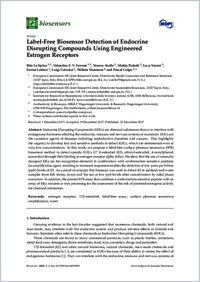Label-free biosensor detection of endocrine disrupting compounds using engineered estrogen receptors
- La Spina, Rita European Commission–DG Joint Research Centre, Directorate Health Consumer and Reference Materials, 21027 Ispra, Italy
- Ferrero, Valentina E. V. European Commission–DG Joint Research Centre, Directorate Sustainable Resources, 21027 Ispra, Italy
- Aiello, Venera European Commission–DG Joint Research Centre, Directorate Health Consumer and Reference Materials, 21027 Ispra, Italy
- Pedotti, Mattia Institute for Research in Biomedicine (IRB), Faculty of Biomedical Sciences, Università della Svizzera italiana, Switzerland
- Varani, Luca Institute for Research in Biomedicine (IRB), Faculty of Biomedical Sciences, Università della Svizzera italiana, Switzerland
- Lettieri, Teresa European Commission–DG Joint Research Centre, Directorate Sustainable Resources, 21027 Ispra, Italy
- Calzolai, Luigi European Commission–DG Joint Research Centre, Directorate Health Consumer and Reference Materials, 21027 Ispra, Italy
- Haasnoot, Willem Authenticity & Bioassays, RIKILT Wageningen University & Research, Wageningen University, 6708 WB Wageningen, The Netherlands
- Colpo, Pascal European Commission–DG Joint Research Centre, Directorate Health Consumer and Reference Materials, 21027 Ispra, Italy
-
22.12.2017
Published in:
- Biosensors. - 2018, vol. 8, no. 1, p. 1-15
English
Endocrine Disrupting Compounds (EDCs) are chemical substances shown to interfere with endogenous hormones affecting the endocrine, immune and nervous systems of mammals. EDCs are the causative agents of diseases including reproductive disorders and cancers. This highlights the urgency to develop fast and sensitive methods to detect EDCs, which are detrimental even at very low concentrations. In this work, we propose a label-free surface plasmon resonance (SPR) biosensor method to detect specific EDCs (17 β-estradiol (E2), ethinyl-estradiol, 4-nonylphenol, tamoxifen) through their binding to estrogen receptor alpha (ERα). We show that the use of rationally designed ERα (as bio-recognition element) in combination with conformation-sensitive peptides (as amplification agent, resulting in increased responses) enables the detection of low parts per billion (ppb) levels of E2. As a proof of concept, this bioassay was used to detect E2 in (spiked) real water samples from fish farms, rivers and the sea at low ppb levels after concentration by solid phase extraction. In addition, the present SPR assay that combines a conformation-sensitive peptide with an array of ERα mutants is very promising for the assessment of the risk of potential estrogenic activity for chemical substances.
- Language
-
- English
- Classification
- Medicine
- License
- Open access status
- gold
- Identifiers
-
- RERO DOC 327174
- DOI 10.3390/bios8010001
- ARK ark:/12658/srd1319216
- Persistent URL
- https://n2t.net/ark:/12658/srd1319216
Statistics
Document views: 193
File downloads:
- Texte intégral: 288
